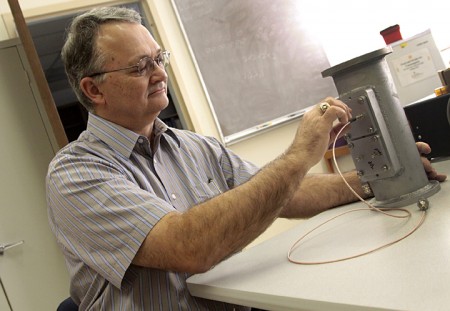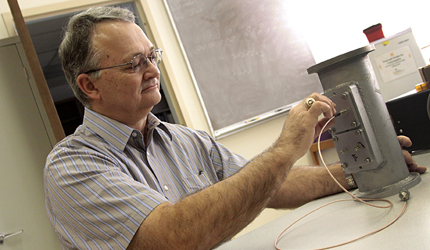
Dr. Randall Jean, associate professor of electrical and computer engineering, works on a device that will enable the monitoring of water levels in concrete Monday in the Marrs McLean Science Building.
By Meghan Hendrickson
Staff Writer
With America’s infrastructure aging and the need to repair and replace roads, bridges and other structures growing more pressing, Baylor engineers are researching ways to build more sound structures for a fraction of the cost.
Dr. Randall Jean, associate professor of electrical and computer engineering, said he has only recently been able to collect the data that is needed to advance the design of a sensor that can measure the properties of concrete using electromagnetic energy in the microwave portion of the spectrum.
Jean and his team are working to develop a sensor that can measure the water-to-cement material ratio in freshly mixed concrete. He said the ratio is vital to determining the strength and durability of concrete after it has been placed and cured.
“High-performance concrete, such as that used in bridges and tall buildings, is a carefully designed product, but there is currently no way for the concrete mixture to be tested to determine if it has been formulated according to the required design,” Jean said. “Our sensor uses ultra wideband electromagnetic pulses to measure the electrical properties of the concrete mixture to confirm that it has been properly formulated and that the mixture has not been altered along the way from the mixing plant to the site where it will be placed.”
Brandon Herrera, electrical and computer engineering master’s candidate, has been working on the measurement hardware for his Master’s thesis.
Herrera said Jean’s research will lead to more precise concrete mixtures, which will enable strength to be maximized.
“The main benefit would give civil engineers the ability to use concrete with strength and durability closer to their designs,” Herrera said. “This would aid in the prevention of disasters from concrete failure such as the BP oil spill.”
Currently, high-performance concrete uses more cement than is necessary to assure the concrete will be of adequate strength, Jean said. This over use of cement significantly increases costs and causes the concrete to be less durable.
“If a robust and accurate measurement can be made at the work site, then less cement can be included in the original mixture without sacrificing strength,” Jean said.
Jean said cement is an energy intensive material, so using less cement saves both energy and money.
“The new hardware allows for the measurements to be taken at an economically viable price point,” Herrera said. “We are expecting to finish the prototype in less than two months.”
Eric Robinson, electrical and computer engineering master’s candidate, has been helping Jean process the data he collected this past summer.
“The goal of the research is to predict types of concrete based on its characteristics,” Robinson said. “For example, the concrete used on a house is different than the concrete used on a bridge; with this research we hope to use a more automated process to mix concrete.”
Robinson said one benefit would be for concrete orders to be placed in a particular location and have the proper type delivered on site in another location, in addition to being able to create mixtures of concrete that can improve the life of structures.
Jean is building a sensor in a challenging construction environment. He said the concrete industry is quite hostile to electronics and part of his job is to develop a sensor that can withstand the rough and dirty environment. He also said concrete made in different seasons and geographical locations often needs to be different.
In the face of added challenges, Jean said he still loves the research he gets to do at Baylor.
“My favorite thing is developing technology that can make a difference in the lives of people,” Jean said.
Waco senior Josh Daniliuc began as an assistant researcher for Jean two summers ago and has since applied class work to practical lab experience.
“As an undergraduate, I greatly appreciate the hands-on experience with technology that can be applied to increase road safety for the millions of people who use our public roads and bridges, with the added bonus of knowing this will save a lot of hard-earned taxpayer money,” Daniliuc said.



